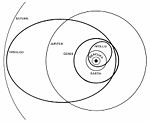(944) Hidalgo
|
Asteroid (944) Hidalgo |
|
|---|---|
| Properties of the orbit ( animation ) | |
| Orbit type | centaur |
| Major semi-axis | 5.7365 AU |
| eccentricity | 0.6618 |
| Perihelion - aphelion | 1.9401 AU - 9.5330 AU |
| Inclination of the orbit plane | 42.5354 ° |
| Sidereal period | 13.74 a |
| Mean orbital velocity | 12.43 km / s |
| Physical Properties | |
| Medium diameter | 38 km |
| Dimensions | 8.4 x 10 15 kg |
| Albedo | 0.060 |
| Rotation period | 10,063 h |
| Absolute brightness | 10.77 mag |
| Spectral class | D. |
| history | |
| Explorer | Walter Baade |
| Date of discovery | October 31, 1920 |
| Another name | 1920 HZ |
| Source: Unless otherwise stated, the data comes from JPL Small-Body Database Browser . The affiliation to an asteroid family is automatically determined from the AstDyS-2 database . Please also note the note on asteroid items. | |
(944) Hidalgo is an asteroid whose extremely elliptical orbit runs from the inner asteroid belt ( perihelion 1.9401 AU ) to beyond the orbit of Saturn ( aphelion 9.5330 AU ). The orbit is strongly inclined towards the ecliptic at 42.5354 ° .
Orbit
Hidalgo needs more than 13.7 years to complete one cycle. The extraordinary orbit suggests that Hidalgo is the remains of a comet . This is also supported by its low albedo of 0.06 and its spectral properties . Its mean diameter is around 38 km. Hidalgo is the object in the solar system that comes closest to the orbit of Saturn without crossing it . Its orbital plane, which is strongly inclined towards the ecliptic, is possibly due to disturbances by the force of gravity of Jupiter.
discovery
The asteroid was discovered on October 31, 1920 by Walter Baade at the Bergedorf observatory near Hamburg. German astronomers were able to observe the total solar eclipse on September 10, 1923 in Mexico , and they were also received by the then Mexican President. In recognition of this, the asteroid was named after the Mexican national hero Miguel Hidalgo y Costilla (1753-1811).
See also
Individual evidence
- ↑ (944) Hidalgo in the Small-Body Database of the Jet Propulsion Laboratory (English).
